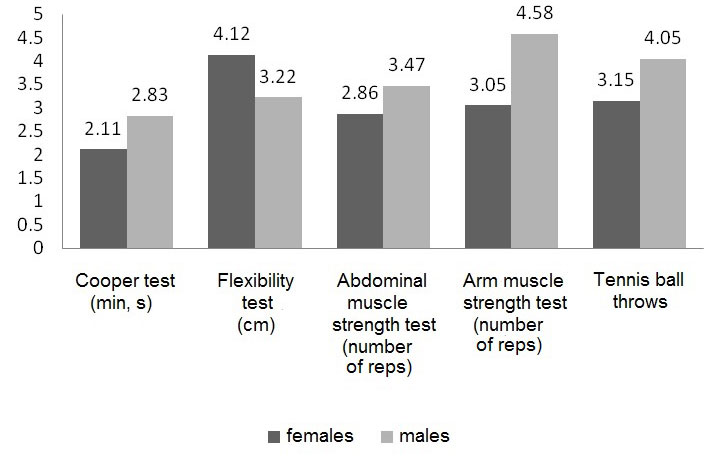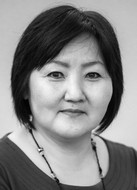Academic physical education efficiency improvement based on first-year students’ physical fitness test data
Фотографии:
ˑ:
PhD, Associate Professor M.I. Sentizova1
A.V. Guryeva1
E.I. Savvinova1
A.G. Barakhsina1
1Institute of Physical Culture and Sport of Ammosov North-Eastern Federal University, Yakutsk
Keywords: physical fitness, physical education, test, control.
Introduction. One of the most important factors ensuring man’s health potential as a whole is physical health, which is characterized by the indicators of physical fitness realized within the physical education system.
An important aspect of the academic physical education efficiency improvement is the scientific substantiation of the effectiveness of management of the training process, practical application of innovative forms, means and methods of physical education on the basis of the objective test data on the students’ physical fitness level [3, 2, 4, 5].
Objective of the study was to rate physical fitness of Ammosov North-Eastern Federal University first-year students and apply the test data and analyses for the educational process efficiency improvement in the academic physical education system.
Methods and structure of the study. In September 2017, we carried out an educational test, as part of the annual preventive medical examination of first-year students, to evaluate the level of development of their physical fitness, as well as to qualify them with the health groups for physical education classes (primary, preparatory, special, those temporarily exempted from physical education practices).
The study involved 17-20 year-old (first-year) students of North-Eastern Federal University (NEFU) of all specializations (n=1385). They were subjected to five tests (see Table 1).
|
No |
Test |
Evaluation criteria |
||||||||||||||||||||||||||||
|
1 |
Cooper 1.5-mile walk/ run test (min, s) General endurance-rating test |
|
||||||||||||||||||||||||||||
|
2
|
Standing bends forward on a gymnastic bench (cm) Flexibility-rating test |
|
||||||||||||||||||||||||||||
|
3 |
Sit-ups (number of reps per 1 minute) Abdominal muscle-strength-rating test |
|
||||||||||||||||||||||||||||
|
4 |
Dip-ups. Arm-muscle-strength-rating test (number of reps) |
|
||||||||||||||||||||||||||||
|
5 |
Tennis ball throws on target (points). Agility-rating test |
|
||||||||||||||||||||||||||||
Results and discussion. The NEFU students’ physical fitness test rates are presented in Figure 1.

Figure 1. Physical fitness test rates in first-year students
The test rates varied widely in both male and female students. In terms of the Cooper 1.5-mile (2400 m) walk/ run test (min, s), the girls’ mean value was 17 min 01 s ((+1.1 s), with the best result being 11 min 45 s, the worst - 23 min 15 s; the spread of values amounted to 11 min 07 s. The boys’ mean value was 12 min 21 s (+1.3 s), with the best result being 10 min 45 s, the worst - 16 min 12 s; the spread of values amounted to 6 min 17 s.
When studying the level of development of the students’ strength qualities, we observed high variability of values in both boys and girls. In the dip-up test, with the mean value being 6+1 number of reps, the minimum and maximum results of the girls were 0 and 10, respectively. The same was true for the boys. With the mean test value being 20+1 number of reps, the spread of values amounted to 19.
High intra-group variability was detected in strength and endurance-rating tests,. In the sit-up test (number of sit-ups from a supine position per 1 min), with the mean value being 20+1 number of reps, the girls’ minimum and maximum results were 10 and 47, respectively. The boys’ minimum and maximum values equaled 20 and 51, respectively, with the mean value being 30+1 number of reps.
In the test "Standing bends forward on a gymnastic bench", the girls demonstrated the result of 13+0.5 cm on average, with the best result being 28 cm, the worst - 6+0.5 cm versus 1+0.5 cm, 20+0.5 cm and - 10+0.5 cm respectively in the boys’ group.
The flexibility level was determined using the "Tennis ball throw on target" test. The subjects were to perform 10 throws from the distance of 6 m into a fixed gymnastic hoop 90 cm in diameter, 1 hit = 1 point. According to the test results, both girls and boys demonstrated highly variable results. The mean value in the girls was 5 points with the minimum and maximum results being 1 and 10 points, respectively, versus 7 points and 4 and 10 points, respectively, for the boys.
When evaluating the physical fitness level using O.E. Aksenova’s method and K. Cooper's test we singled out five levels of general physical fitness: very poor (one), poor (two), satisfactory (three), good (four), excellent (five) [1].
Conclusions. The proposed test system helps objectively estimate general physical fitness of first-year students. Further studies are needed to analyze the students’ physical progress and secure due motivations for the academic physical education and sports. The physical fitness test system described in the article eliminates the possibility of ambiguous interpretation of the obtained test data and directs physical education teachers towards making specific pedagogical decisions highly helpful for the academic physical education process improvement purposes.
References
- Askenova O.E. Soderzhanie i organizatsiya adaptivnoy fizicheskoy kultury v professionalnoy podgotovke studentov vysshego uchebnogo zavedeniya [Content and organization of adaptive physical education process in vocational training of higher school students]. Lesgaft NSUPESH, St. Petersburg: [s.n.], 2009, 123 p.
- Korolev V.G., Bardushkin V.V. Analiz ekvivalentnosti normativov dlya otsenki urovnya fizicheskoy podgotovlennosti studentov i voennosluzhaschikh [Students and military personnel’s physical fitness level standards equivalence analysis]. Ekonomicheskie i sotsialno-gumanitarnye issledovaniya, 2015, no. 3.
- Lysova I.A., Blinova A.V., Nechushkin Yu.V. Otsenka obschey fizicheskoy podgotovlennosti studentov [Assessment of body conditioning level of students] [Electronic resource]. Moscow: MUH publ., 2012, 201 p.
- Ushakov A.S., Nenasheva A.V., Kleshchenkova N.E. Sravnitelny analiz pokazateley fizicheskoy podgotovlennosti uchaschikhsya 11-kh klassov i studentov 1-go kursa obucheniya [Comparative analysis of physical fitness indicators of 11th graders and 1st-year students]. Vestnik Yuzhno-Uralskogo gosudarstvennogo universiteta. Ser.: Obrazovanie, zdravookhranie, fizicheskaya kultura, 2014, no. 2.
-
Cherkashin I.A., Okhlopkov P.P., Migalkin A.G., Danilov M.V. Otsenka fizicheskoy podgotovlennosti kvalifitsirovannykh sportsmenov v tayskom bokse [Physical fitness tests of highly skilled Muay Thai fighters]. Teoriya i praktika fiz. kultury, 2017, no. 7, pp. 69-72.
Corresponding author: 706037@mail.ru
Abstract
The mission of the academic Physical Education Department is to develop the students’ motor skills and abilities and improve their physical qualities; with the mission being facilitated by new efficient physical education methods and tools. For success of the mission, the university faculty should make initial physical fitness tests to estimate the first-year students’ physical fitness to prudently design and manage the physical education process.
Objective of the study was to estimate physical fitness of the Ammosov North-Eastern Federal University first-year students and apply the test data and analyses for the educational process efficiency improvement in the academic physical education system. The proposed test system makes it possible to objectively estimate general physical fitness of first-year students. Further studies are needed to analyze the students’ physical progress and secure due motivations for the academic physical education and sports. The physical fitness test system described in the article provides the means to obtain objective test data highly helpful for the academic physical education process improvement purposes.



